2014 MERCEDES-BENZ SLK-Class winter tires
[x] Cancel search: winter tiresPage 310 of 354

is approximately
00CDin (1.6 mm). If this is the
case, the tire is so worn that it must be
replaced. Selecting, mounting and replacing
tires
R Only mount tires and wheels of the same
type and make.
Exception: it is permissible to install a
different type or make in the event of a flat
tire. Observe the "MOExtended tires (tires
with run-flat characteristics" section
(Y page 290).
R Only mount tires of the correct size onto
the wheels.
R Break in new tires at moderate speeds for
the first 60 miles (100 km). They only reach
their full performance after this distance.
R Do not drive with tires which have too little
tread depth, as this significantly reduces
the traction on wet roads (hydroplaning).
R Replace the tires after six years at the
latest, regardless of wear. MOExtended tires (tires with run-flat
properties)
With MOExtended tires (tires with run flat
characteristics), you can continue to drive
your vehicle even if there is a total loss of
pressure in one or more tires.
MOExtended tires may only be used in
conjunction with an active tire pressure loss
warning system or with an active tire pressure
monitor and on wheels specifically tested by
Mercedes-Benz.
Notes on driving with MOExtended tires with
a flat tire (Y page 290).
i Vehicles equipped with MOExtended tires
are not equipped with a TIREFIT kit at the
factory. It is therefore recommended that
you additionally equip your vehicle with a
TIREFIT kit if you mount tires that do not
feature run-flat properties, e.g. winter tires. A TIREFIT kit can be obtained from a
qualified specialist workshop. Winter operation
General notes
Have your vehicle winterproofed at a qualified
specialist workshop at the onset of winter.
Observe the notes in the "Changing a wheel"
section (Y page 328). Driving with summer tires
At temperatures below 45 ‡(+7 †), summer
tires lose elasticity and therefore traction and
braking power. Change the tires on your
vehicle to M+S tires. Using summer tires at
very cold temperatures could cause cracks to
form, thereby damaging the tires
permanently. Mercedes-Benz cannot accept
responsibility for this type of damage. M+S tires
G
WARNING
M+S tires with a tire tread depth of less than
00CF in (4 mm) are not suitable for use in winter
and do not provide sufficient traction. There
is a risk of an accident.
M+S tires with a tread depth of less than 00CF
in (4 mm) must be replaced immediately.
At temperatures below 45 ‡ (+7 †), use
winter tires or all-season tires. Both types of
tire are identified by the M+S marking.
Only winter tires bearing the 004Dsnowflake
symbol in addition to the M+S marking
provide the best possible grip in wintry road
conditions.
Only these tires will allow driving safety
systems such as ABS and ESP ®
to function
optimally in winter. These tires have been
developed specifically for driving in snow. 308
Winter operationWheels and tires
Page 311 of 354
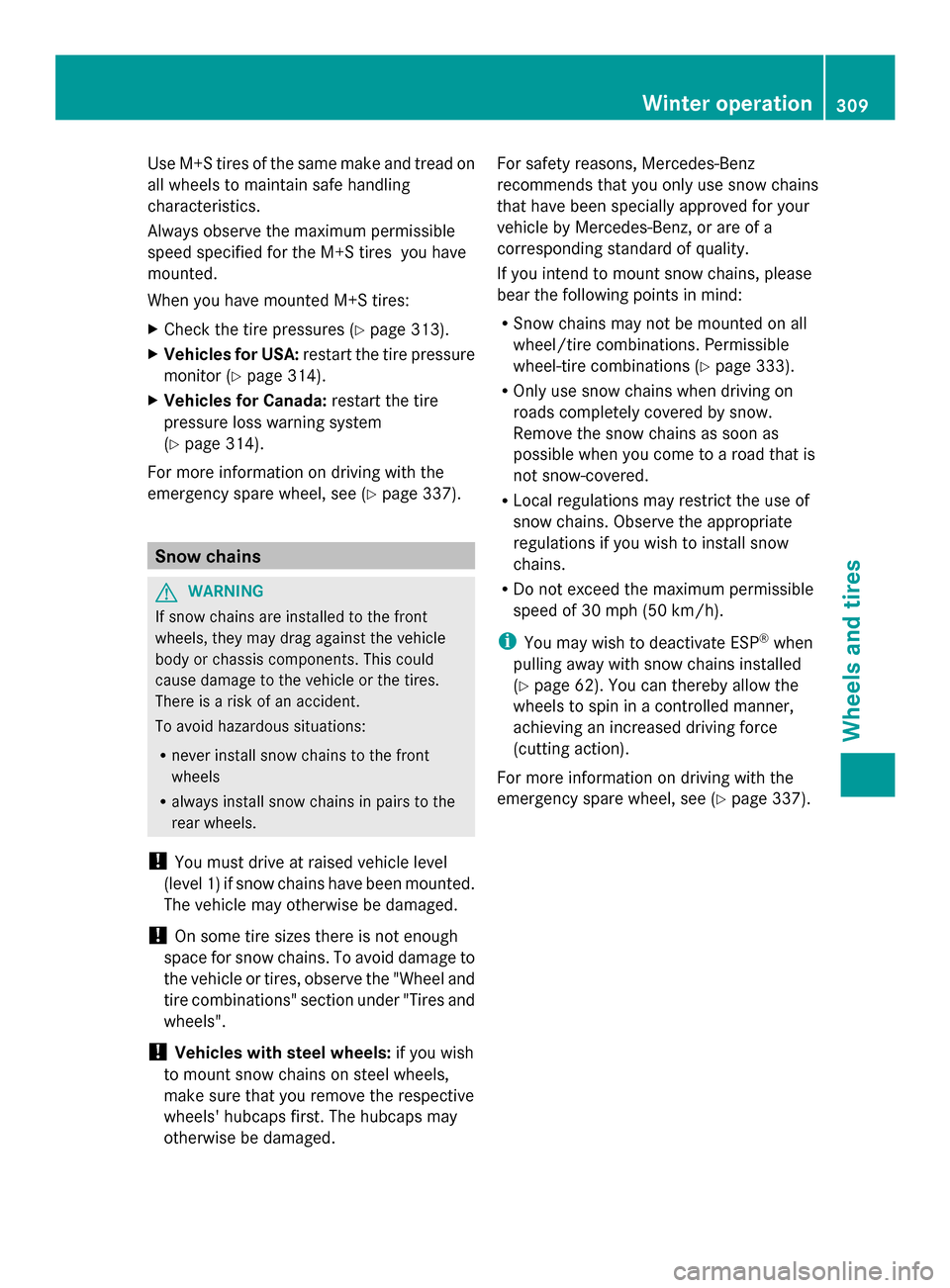
Use M+S tires of the same make and tread on
all wheels to maintain safe handling
characteristics.
Always observe the maximum permissible
speed specified for the M+S tires you have
mounted.
When you have mounted M+S tires:
X Check the tire pressures (Y page 313).
X Vehicles for USA: restart the tire pressure
monitor (Y page 314).
X Vehicles for Canada: restart the tire
pressure loss warning system
(Y page 314).
For more information on driving with the
emergency spare wheel, see (Y page 337).Snow chains
G
WARNING
If snow chains are installed to the front
wheels, they may drag against the vehicle
body or chassis components. This could
cause damage to the vehicle or the tires.
There is a risk of an accident.
To avoid hazardous situations:
R never install snow chains to the front
wheels
R always install snow chains in pairs to the
rear wheels.
! You must drive at raised vehicle level
(level 1) if snow chains have been mounted.
The vehicle may otherwise be damaged.
! On some tire sizes there is not enough
space for snow chains. To avoid damage to
the vehicle or tires, observe the "Wheel and
tire combinations" section under "Tires and
wheels".
! Vehicles with steel wheels: if you wish
to mount snow chains on steel wheels,
make sure that you remove the respective
wheels' hubcaps first. The hubcaps may
otherwise be damaged. For safety reasons, Mercedes-Benz
recommends that you only use snow chains
that have been specially approved for your
vehicle by Mercedes-Benz, or are of a
corresponding standard of quality.
If you intend to mount snow chains, please
bear the following points in mind:
R
Snow chains may not be mounted on all
wheel/tire combinations. Permissible
wheel-tire combinations (Y page 333).
R Only use snow chains when driving on
roads completely covered by snow.
Remove the snow chains as soon as
possible when you come to a road that is
not snow-covered.
R Local regulations may restrict the use of
snow chains. Observe the appropriate
regulations if you wish to install snow
chains.
R Do not exceed the maximum permissible
speed of 30 mph (50 km/h).
i You may wish to deactivate ESP ®
when
pulling away with snow chains installed
(Y page 62). You can thereby allow the
wheels to spin in a controlled manner,
achieving an increased driving force
(cutting action).
For more information on driving with the
emergency spare wheel, see (Y page 337). Winter operation
309Wheels and tires Z
Page 323 of 354
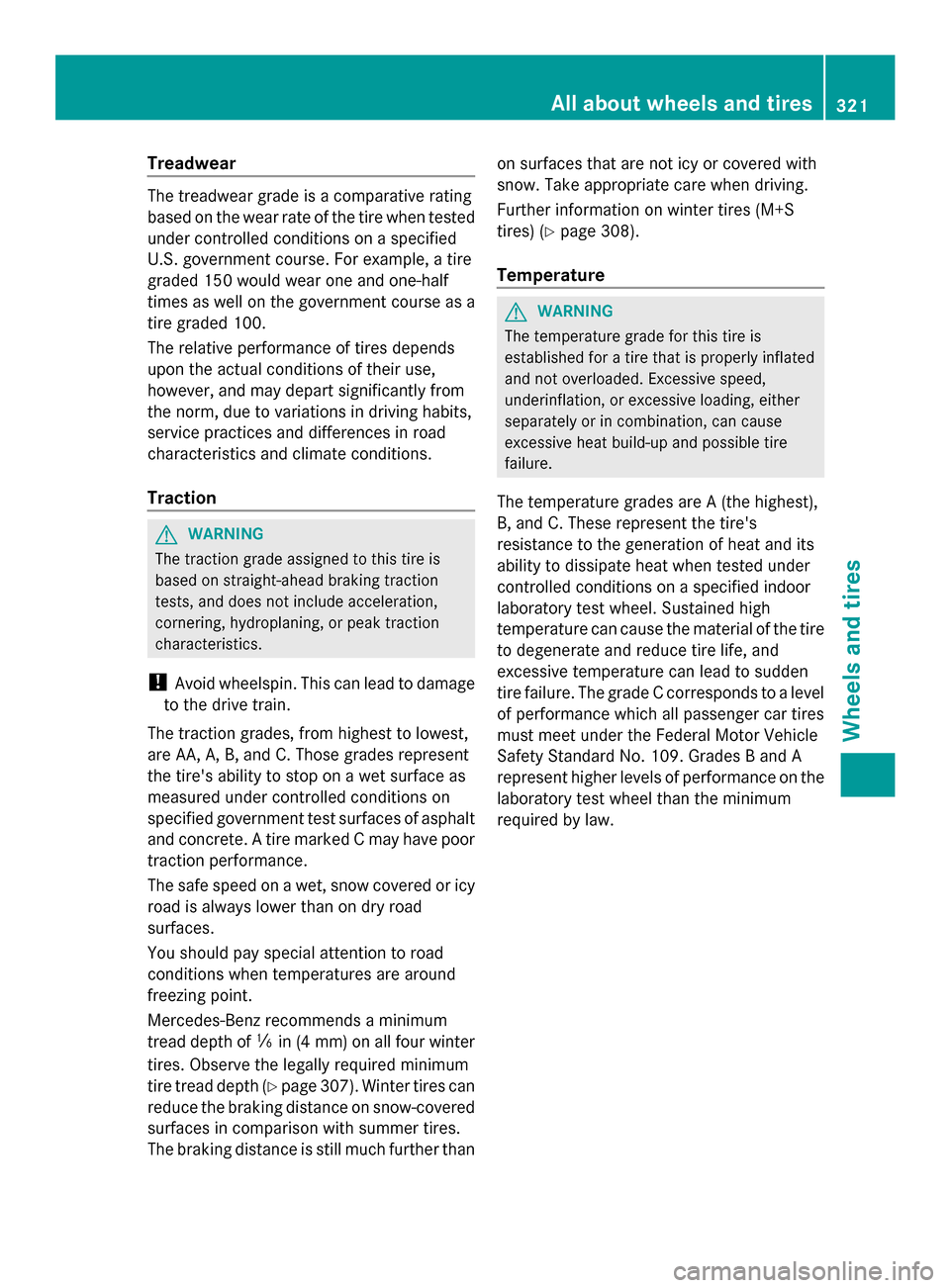
Treadwear
The treadwear grade is a comparative rating
based on the wear rate of the tire when tested
under controlled conditions on a specified
U.S. government course. For example, a tire
graded 150 would wear one and one-half
times as well on the government course as a
tire graded 100.
The relative performance of tires depends
upon the actual conditions of their use,
however, and may depart significantly from
the norm, due to variations in driving habits,
service practices and differences in road
characteristics and climate conditions.
Traction G
WARNING
The traction grade assigned to this tire is
based on straight-ahead braking traction
tests, and does not include acceleration,
cornering, hydroplaning, or peak traction
characteristics.
! Avoid wheelspin. This can lead to damage
to the drive train.
The traction grades, from highest to lowest,
are AA, A, B, and C. Those grades represent
the tire's ability to stop on a wet surface as
measured under controlled conditions on
specified government test surfaces of asphalt
and concrete. A tire marked C may have poor
traction performance.
The safe speed on a wet, snow covered or icy
road is always lower than on dry road
surfaces.
You should pay special attention to road
conditions when temperatures are around
freezing point.
Mercedes-Benz recommends a minimum
tread depth of 00CFin(4 mm) on all four winter
tires. Observe the legally required minimum
tire tread depth (Y page 307). Winter tires can
reduce the braking distance on snow-covered
surfaces in comparison with summer tires.
The braking distance is still much further than on surfaces that are not icy or covered with
snow. Take appropriate care when driving.
Further information on winter tires (M+S
tires) (Y
page 308).
Temperature G
WARNING
The temperature grade for this tire is
established for a tire that is properly inflated
and not overloaded. Excessive speed,
underinflation, or excessive loading, either
separately or in combination, can cause
excessive heat build-up and possible tire
failure.
The temperature grades are A (the highest),
B, and C. These represent the tire's
resistance to the generation of heat and its
ability to dissipate heat when tested under
controlled conditions on a specified indoor
laboratory test wheel. Sustained high
temperature can cause the material of the tire
to degenerate and reduce tire life, and
excessive temperature can lead to sudden
tire failure. The grade C corresponds to a level
of performance which all passenger car tires
must meet under the Federal Motor Vehicle
Safety Standard No. 109. Grades B and A
represent higher levels of performance on the
laboratory test wheel than the minimum
required by law. All about wheels and tires
321Wheels and tires Z
Page 326 of 354

275/40 ZR 18 (99 Y). Speed rating "(Y)"
indicates that the maximum speed of the
tire is over 186 mph (300 km/h). Ask the
tire manufacturer about the maximum
speed. All-
weather
tires
and
winter
tires
Index Speed rating
Q M+S
4 up to 100 mph (160 km/h)
T M+S
4 up to 118 mph (190 km/h)
H M+S
4 up to 130 mph (210 km/h)
V M+S
4 up to 149 mph (240 km/h)
i
Not all tires with the M+S marking provide
the driving characteristics of winter tires.
In addition to the M+S marking, winter tires
also have the 004Dsnowflake symbol on
the tire wall. Tires with this marking fulfill
the requirements of the Rubber
Manufacturers Association (RMA) and the
Rubber Association of Canada (RAC)
regarding the tire traction on snow. They
have been especially developed for driving
on snow.
An electronic speed limiter prevents your
vehicle from exceeding the following speeds:
R all vehicles (except AMG vehicles):
130 mph (210 km/h)
R AMG vehicles: 155 mph (250 km/h)
R AMG vehicles with Handling Package:
174 mph (280 km/h)
The speed rating of tires mounted at the
factory may be higher than the maximum
speed that the electronic speed limiter
permits.
Make sure that your tires have the required
speed rating, e.g. when buying new tires. The required speed rating for your vehicle can be
found in the "tires" section (Y
page 333).
Further information about reading tire data
can be obtained from any qualified specialist
workshop.
Load index In addition to the load bearing index, load
rating
0043may be imprinted after the letters
that identify speed rating on the sidewall of
the tire (Y page 322).
R If no specification is given: no text (as in the
example above), represents a standard
load (SL) tire
R XL or Extra Load: represents a reinforced
tire
R Light Load: represents a light load tire
R C, D, E: represents a load range that
depends on the maximum load that the tire
can carry at a certain pressure
i Tire data is vehicle-specific and may
deviate from the data in the example.
4 Or M+S004D for winter tires.324
All about wheels and tiresWheels and tires
Page 336 of 354
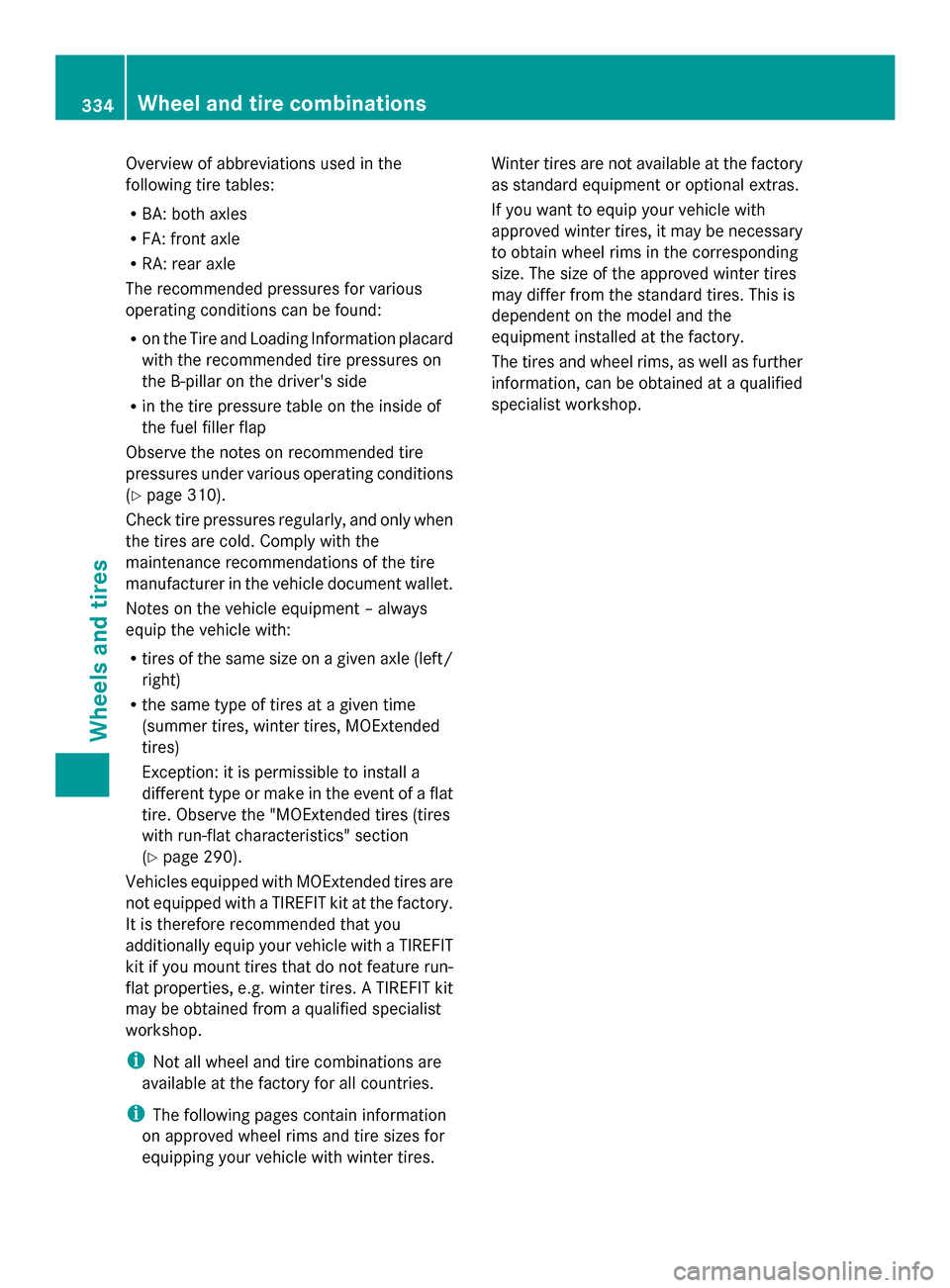
Overview of abbreviations used in the
following tire tables:
R BA: both axles
R FA: front axle
R RA: rear axle
The recommended pressures for various
operating conditions can be found:
R on the Tire and Loading Information placard
with the recommended tire pressures on
the B-pillar on the driver's side
R in the tire pressure table on the inside of
the fuel filler flap
Observe the notes on recommended tire
pressures under various operating conditions
(Y page 310).
Check tire pressures regularly, and only when
the tires are cold. Comply with the
maintenance recommendations of the tire
manufacturer in the vehicle document wallet.
Notes on the vehicle equipment – always
equip the vehicle with:
R tires of the same size on a given axle (left/
right)
R the same type of tires at a given time
(summer tires, winter tires, MOExtended
tires)
Exception: it is permissible to install a
different type or make in the event of a flat
tire. Observe the "MOExtended tires (tires
with run-flat characteristics" section
(Y page 290).
Vehicles equipped with MOExtended tires are
not equipped with a TIREFIT kit at the factory.
It is therefore recommended that you
additionally equip your vehicle with a TIREFIT
kit if you mount tires that do not feature run-
flat properties, e.g. winter tires. A TIREFIT kit
may be obtained from a qualified specialist
workshop.
i Not all wheel and tire combinations are
available at the factory for all countries.
i The following pages contain information
on approved wheel rims and tire sizes for
equipping your vehicle with winter tires. Winter tires are not available at the factory
as standard equipment or optional extras.
If you want to equip your vehicle with
approved winter tires, it may be necessary
to obtain wheel rims in the corresponding
size. The size of the approved winter tires
may differ from the standard tires. This is
dependent on the model and the
equipment installed at the factory.
The tires and wheel rims, as well as further
information, can be obtained at a qualified
specialist workshop.334
Wheel and tire combinationsWheels and tires
Page 337 of 354
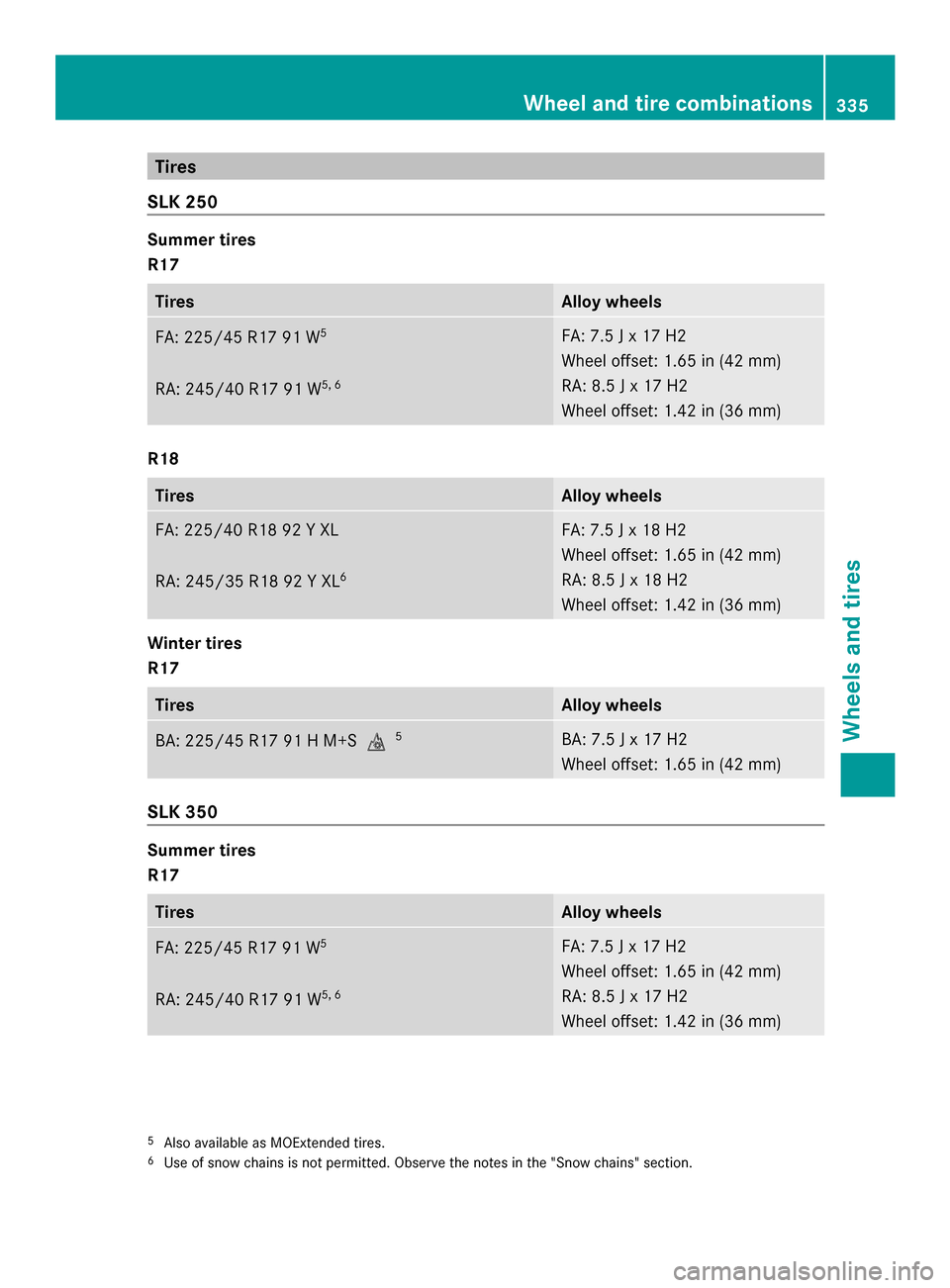
Tires
SLK 250 Summer tires
R17
Tires Alloy wheels
FA: 225/4
5 R17 91 W 5
RA : 245/40 R17 91 W 5, 6 FA: 7.5 J x 17 H2
Wheel offset: 1.65 in (42 mm)
RA: 8.5 J x 17 H2
Wheel offset: 1.42 in (36 mm)
R18
Tires Alloy wheels
FA: 225/40 R18 92 Y XL
RA: 245/35 R18 92 Y XL
6 FA: 7.5 J x 18 H2
Wheel offset: 1.65 in (42 mm)
RA: 8.5 J x 18 H2
Wheel offset: 1.42 in (36 mm)
Winter tires
R17
Tires Alloy wheels
BA: 225/45 R17 91 H M+S
004D5 BA: 7.5 J x 17 H2
Wheel offset: 1.65 in (42 mm)
SLK 350
Summer tires
R17
Tires Alloy wheels
FA: 225/45 R17 91 W
5
RA: 245/40 R17 91 W 5, 6 FA: 7.5 J x 17 H2
Wheel offset: 1.65 in (42 mm)
RA: 8.5 J x 17 H2
Wheel offset: 1.42 in (36 mm)
5
Also available as MOExtended tires.
6 Use of snow chains is not permitted. Observe the notes in the "Snow chains" section. Wheel and tire combinations
335Wheels and tires Z
Page 338 of 354
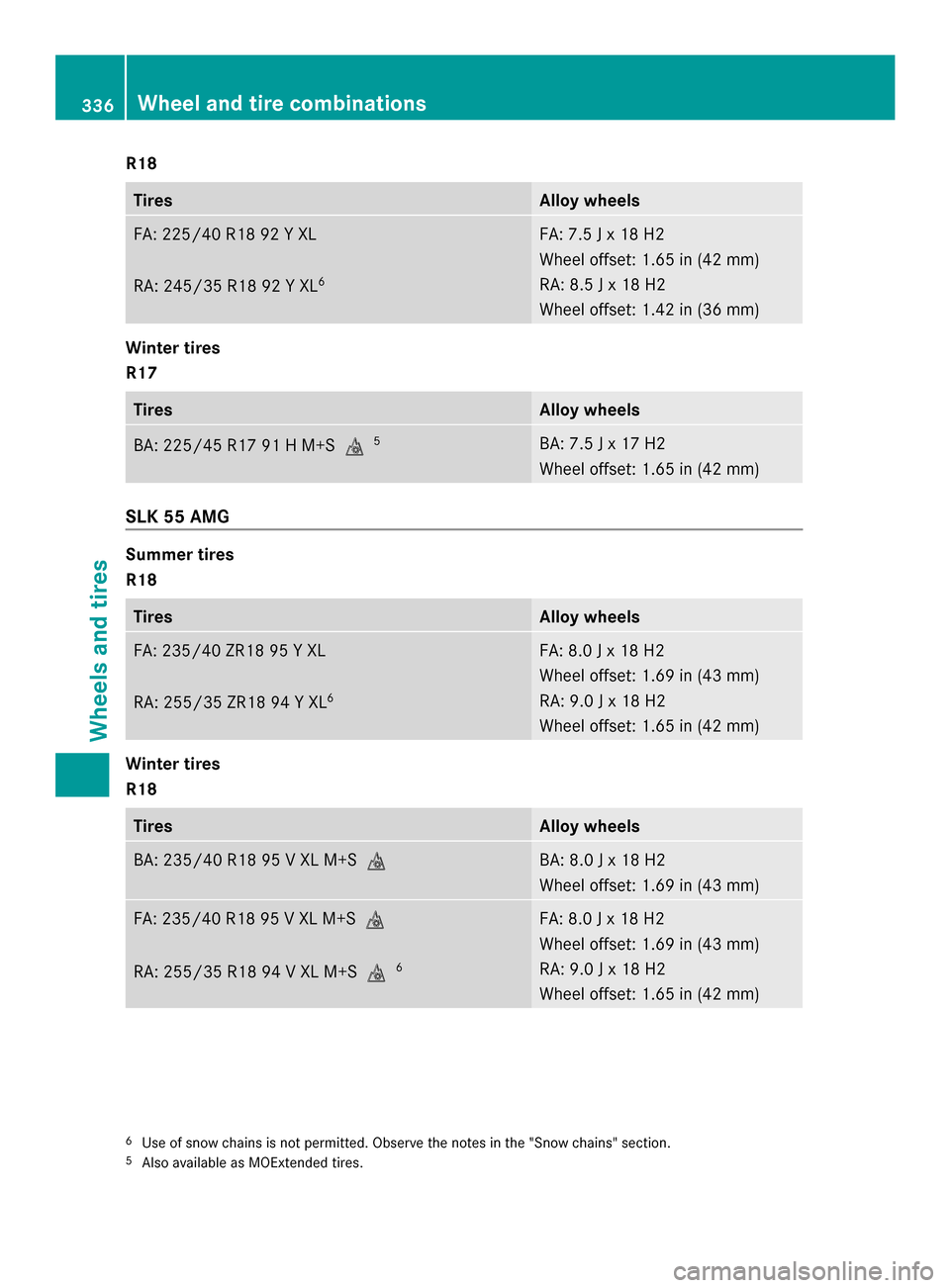
R18
Tires Alloy wheels
FA: 225/40 R18 92 Y XL
RA: 245/35 R18 92 Y XL
6 FA: 7.5 J x 18 H2
Wheel offset: 1.65 in (42 mm)
RA: 8.5 J x 18 H2
Wheel offset: 1.42 in (36 mm)
Winter tires
R17
Tires Alloy wheels
BA: 225/45 R17 91 H M+S
004D5 BA: 7.5 J x 17 H2
Wheel offset: 1.65 in (42 mm)
SLK 55 AMG
Summer tires
R18
Tires Alloy wheels
FA: 235/40 ZR18 95 Y XL
RA: 255/35 ZR18 94 Y XL
6 FA: 8.0 J x 18 H2
Wheel offset: 1.69 in (43 mm)
RA: 9.0 J x 18 H2
Wheel offset: 1.65 in (42 mm)
Winter tires
R18
Tires Alloy wheels
BA: 235/40 R18 95 V XL M+S
004D BA: 8.0 J x 18 H2
Wheel offset: 1.69 in (43 mm)
FA: 235/40 R18 95 V XL M+S
004D
RA: 255/35 R18 94 V XL M+S 004D6 FA: 8.0 J x 18 H2
Wheel offset: 1.69 in (43 mm)
RA: 9.0 J x 18 H2
Wheel offset: 1.65 in (42 mm)
6
Use of snow chains is not permitted. Observe the notes in the "Snow chains" section.
5 Also available as MOExtended tires. 336
Wheel and tire combinationsWheels and tires